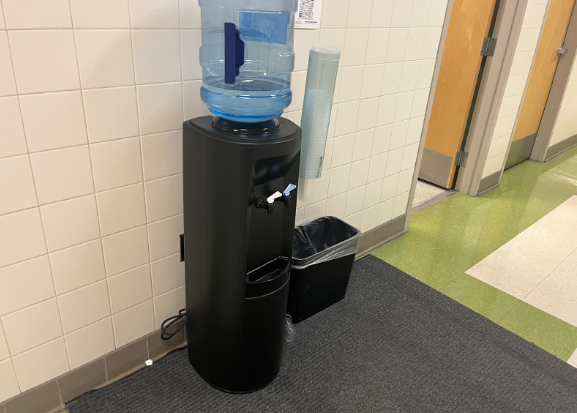On August 30, all water fountains inside Linganore High School were turned off indefinitely. Why?
“Tests at Linganore High School (LHS) detected PFAS levels above the federal standard,” Linganore principal Dr. Michael Dillman said in an email sent out to parents on the night of August 29.
New Regulations
The water in all Maryland schools went through a series of tests over the summer in accordance with the new regulations set forth by the Environmental Protect Agency (EPA).
The Safe Drinking Water Act (1974) allows the EPA to set standards for drinking water. As of April 2024, the EPA has set a new level of chemicals in water considered to be non-hazardous for six types of PFAs.
In public water systems, levels must be disclosed to the public by 2027, and a solution must be set in place by 2029.
According to the EPA, PFOA and PFOS (also known as “forever chemicals”) water will now be limited to 4.0 parts per trillion (ppt) and have a health-based goal of 0. “GenX chemicals” (PFNA and PFHxS) will be limited to 10 ppt.
LHS is just one of 36 schools in Maryland to find chemical levels exceeding federal safety limits, according to WCBM. At Fallston High School located in Maryland, a singular sample found 25 times over the legal limit of PFOS. At LHS, 16.01 ppt of PFOS were found in the water and 10.7 ppt of PFOAs.
Exposure and Effects in the United States
PFAs are incredibly common in American water sources. According to the US Geological Survey, almost half of the tap water in the United States is contaminated with chemicals known as “forever chemicals,” as quoted by CNN.
“This is not a new item in water, as in a chemical, or something that was just found,” Dillman said.
According to the National Institute of Environmental Health Sciences, an estimated 97% of Americans have PFAs in their bloodstream, and the chemicals ha vebeen found in all 50 states.
Despite this fact,a study conducted by Texas A&M University found that 97.4% of Americans did not believe their drinking water had been impacted.
The Maryland Department of Environment is taking the issue seriously, releasing a statement that said:
“The health of schoolchildren is very important to us, which is why the state has a robust early sampling and response system to isolate drinking water sources and see that bottled water is provided when high levels of these contaminants are present.”
According to the Agency for Toxic Substances and Disease Registry, exposure to these contaminants can cause increased cholesterol, weakened liver and immune systems, certain types of cancer, as well as birth defects and other pregnancy related issues. The risk of health effects increases with frequency and duration of exposure.
Water-Related Issues
This is not the first time LHS has shut down their water systems. On September 6, 2023, staff and students found soil contaminating the water.
According to Howie Putterman, coordinator of athletics and facilities, this was a result of several contributing factors that ran one of the school’s wells dry.
A FindOutFirst message was sent out informing LHS families of the situation and sharing that maintenance had flushed and tested the water, and it was safe to consume.
Linganore sophomore Kaydence Pierce said, “The day they told us the water had soil in it, I had drank water earlier that morning … it was yellow.”
In an article for ABC News, Ginger Zee and Kenton Gewecke wrote, “As pollution, engineering, population growth and climate change pose challenges to freshwater quality and quantity in America, the safety and amount of water in parts of the U.S. is in question.”
Cost for FCPS
According to the Frederick News Post, eight different Frederick County Public Schools (FCPS) schools were found to have chemicals above the new legal limit.
This issue poses another problem for FCPS: cost. As of April 2024, FCPS is allegedly struggling with $53 million of debt. The temporary solution of providing water bottles, cups and coolers full of purified water is an expense that these schools likely cannot afford.
According to Jay Apperson, a deputy director for the Maryland Department of Environment, “We will continue to work in partnership with other agencies and local governments on testing, fixing problems and helping to fund the needed improvements.”
Despite the currently implemented solution, students who participate in after-school activities are also limited by not having access to water.
Athletic teams and other groups visiting the school are also notified of the lack of water available upon visiting the school.
“I can tell you that we are going through at least 8 to 9 5-gallon containers/day in the athletic wing on average and then at least another 1 to 3 a day for practices,” Putterman said.
Putterman believes students are now consuming more now that they have “pure, ‘good tasting’ water” available in the coolers.
Families of students in the LHS Marching have been donating plastic water bottles for students to drink during practices.
Pierce, who is a member of the LHS marching band, said, “I bring my own water, or Mr. Lloyd [LHS band director] gives us water.”
Solutions Going Forward
While FCPS has announced it is working on a long-term solution, no further information has been released.
The “biggest impacts have been financial for the county and on the custodial staff, myself and the athletic trainer having to constantly fill and refill water, cups and 5-gallon jugs,” Putterman said.
Dillman indicated that FCPS has not yet identified a way to filter the water but are working on the issue.
On the report of the EPA, there are only three known ways to remove PFAs from water.
One of them is the use of granular activated carbon (GAC). GAC contains organic materials high in carbon. When these materials are heated up without oxygen, they can be used as a filter to remove chemical compounds from water.
Another option is ion exchange resins. According to Atlas Scientific, “Ion exchange is a chemical process to remove unwanted dissolved ions in water and wastewater by exchanging specific ions for ions that have the same charge.”
High pressure membranes such as reverse osmosis can also be effective in removing PFAs from water. Reverse osmosis works by water pressure pushing tap water through a membrane that can filter out harmful chemicals.
However, all of these systems cost thousands of dollars to apply and maintain.
FCPS is currently working on employing a company to test well water in schools in a three-year-contract but has received no proposals back yet. They are hoping to employ a company by limiting the amount of schools to be tested, according to Yahoo News.



















